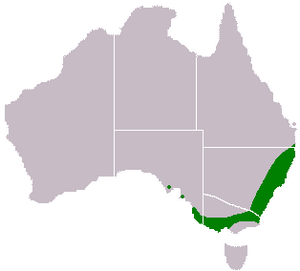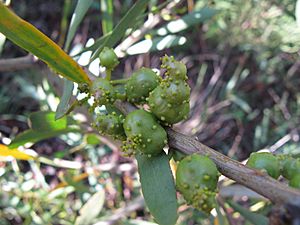Acacia longifolia facts for kids
Quick facts for kids Acacia longifolia |
|
|---|---|
 |
|
| Foliage and blossoms of Acacia longifolia | |
| Scientific classification | |
| Genus: |
Acacia
|
| Species: |
longifolia
|
 |
|
| Range of Acacia longifolia | |
| Synonyms | |
Acacia longifolia is a type of plant from the Acacia family. It's often called the long-leaved wattle, golden wattle, or Sydney golden wattle. This plant is originally from southeastern Australia, including parts of Queensland, New South Wales, Victoria, and South Australia.
It grows very quickly, sometimes reaching 7 to 10 meters (about 23 to 33 feet) tall in just five or six years. While it's native to Australia, it has become an invasive plant in places like Portugal and South Africa. In some parts of Western Australia, it's also considered a weed because it can outcompete local plants.
Contents
What It Looks Like
The golden wattle can grow as a shrub or a tree, reaching up to 8 meters (about 26 feet) tall. It has smooth, grayish bark and smooth branches.
Like most Acacia species, it has special leaf-like structures called phyllodes instead of true leaves. These phyllodes are always green and mostly straight. They can be 4 to 20 centimeters (about 1.5 to 8 inches) long and 4 to 30 millimeters (about 0.15 to 1.2 inches) wide. They have many clear lines running along them.
Flowers and Seed Pods
This plant blooms between June and October in Australia. Its flowers are bright to pale yellow and grow in cylinder shapes that are 2 to 4.5 centimeters (about 0.8 to 1.8 inches) long.
After the flowers, seed pods grow. These pods can be straight or very twisted. They are usually 4 to 15 centimeters (about 1.5 to 6 inches) long and 2.5 to 6 millimeters (about 0.1 to 0.2 inches) wide. When dry, they are quite brittle.
Where It Grows
The golden wattle is found naturally along the coast of southeastern Queensland and down the coast of New South Wales. It also grows south and east through Victoria and into South Australia. In these areas, you can find it in different places, including sand dunes and in sclerophyll woodlands or coastal scrub.
Spread to Other Areas
It has also started growing in the southwest of Western Australia, especially in coastal areas from Perth down to Albany. People think it spread from gardens or from plants used to restore land. To control it, people might pull out young plants or use chemicals on older ones.
How People Use It
Acacia longifolia is grown in many warm parts of the world. It has several uses:
- Stopping soil erosion: Its roots help hold soil in place, especially on sandy coasts.
- Food: The flowers, seeds, and seed pods can be eaten. In Tasmania, people used to roast the pods and eat the seeds.
- Dyes: A yellow dye can be made from the flowers, and a green dye from the pods.
- Wood: The wood can be used for various purposes.
- Tanning: The bark has some use in tanning sheep skins.
Growing Golden Wattle
This plant is seen as attractive, tough, and fast-growing. It's good for creating hedges or screens. It's also used to stabilize soil on banks, like along roadsides. The Sydney golden wattle can grow in different types of soil and can handle frost.
In Southern California, it's often used as a street tree. It grows quickly, can handle dry weather, and is strong even with rough pruning.
However, in Portugal, this species is considered very invasive in sand dunes. Because of this, it is against the law to grow it there.
Controlling Its Spread
In South Africa, a small wasp called Trichilogaster acaciaelongifoliae has been brought from Australia to help control the golden wattle. This wasp lays its eggs in the plant's flower buds, causing them to form galls (unusual growths). These galls greatly reduce the number of seeds the plant can produce, often by more than 90%. The galls also make the plant weaker and cause leaves to fall off, slowing its growth.
Gallery
See also
 In Spanish: Acacia longifolia para niños
In Spanish: Acacia longifolia para niños








